2015 CHRYSLER TOWN AND COUNTRY radiator cap
[x] Cancel search: radiator capPage 584 of 726
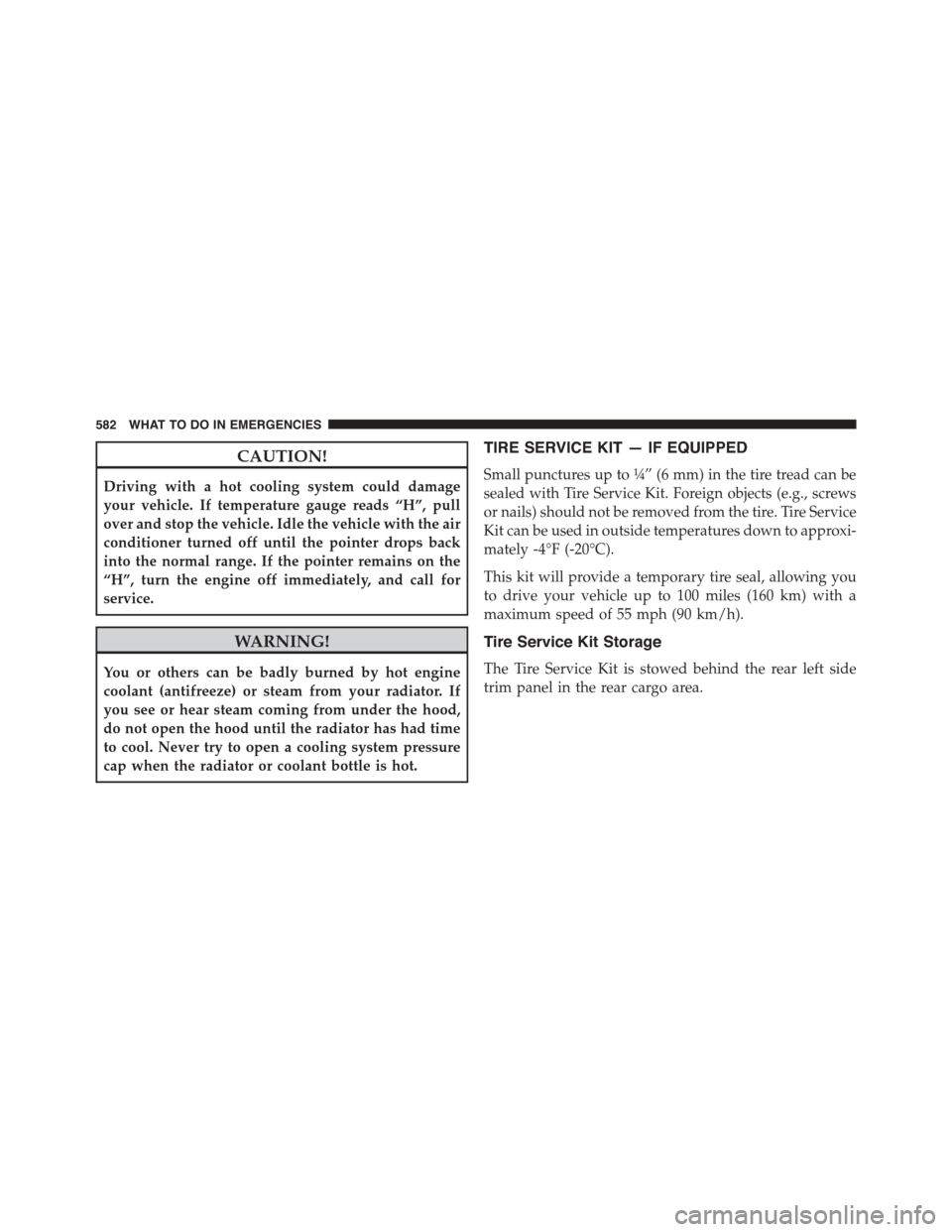
CAUTION!
Driving with a hot cooling system could damage
your vehicle. If temperature gauge reads “H”, pull
over and stop the vehicle. Idle the vehicle with the air
conditioner turned off until the pointer drops back
into the normal range. If the pointer remains on the
“H”, turn the engine off immediately, and call for
service.
WARNING!
You or others can be badly burned by hot engine
coolant (antifreeze) or steam from your radiator. If
you see or hear steam coming from under the hood,
do not open the hood until the radiator has had time
to cool. Never try to open a cooling system pressure
cap when the radiator or coolant bottle is hot.
TIRE SERVICE KIT — IF EQUIPPED
Small punctures up to¼” (6 mm) in the tire tread can be
sealed with Tire Service Kit. Foreign objects (e.g., screws
or nails) should not be removed from the tire. Tire Service
Kit can be used in outside temperatures down to approxi-
mately -4°F (-20°C).
This kit will provide a temporary tire seal, allowing you
to drive your vehicle up to 100 miles (160 km) with a
maximum speed of 55 mph (90 km/h).
Tire Service Kit Storage
The Tire Service Kit is stowed behind the rear left side
trim panel in the rear cargo area.
582 WHAT TO DO IN EMERGENCIES
Page 646 of 726
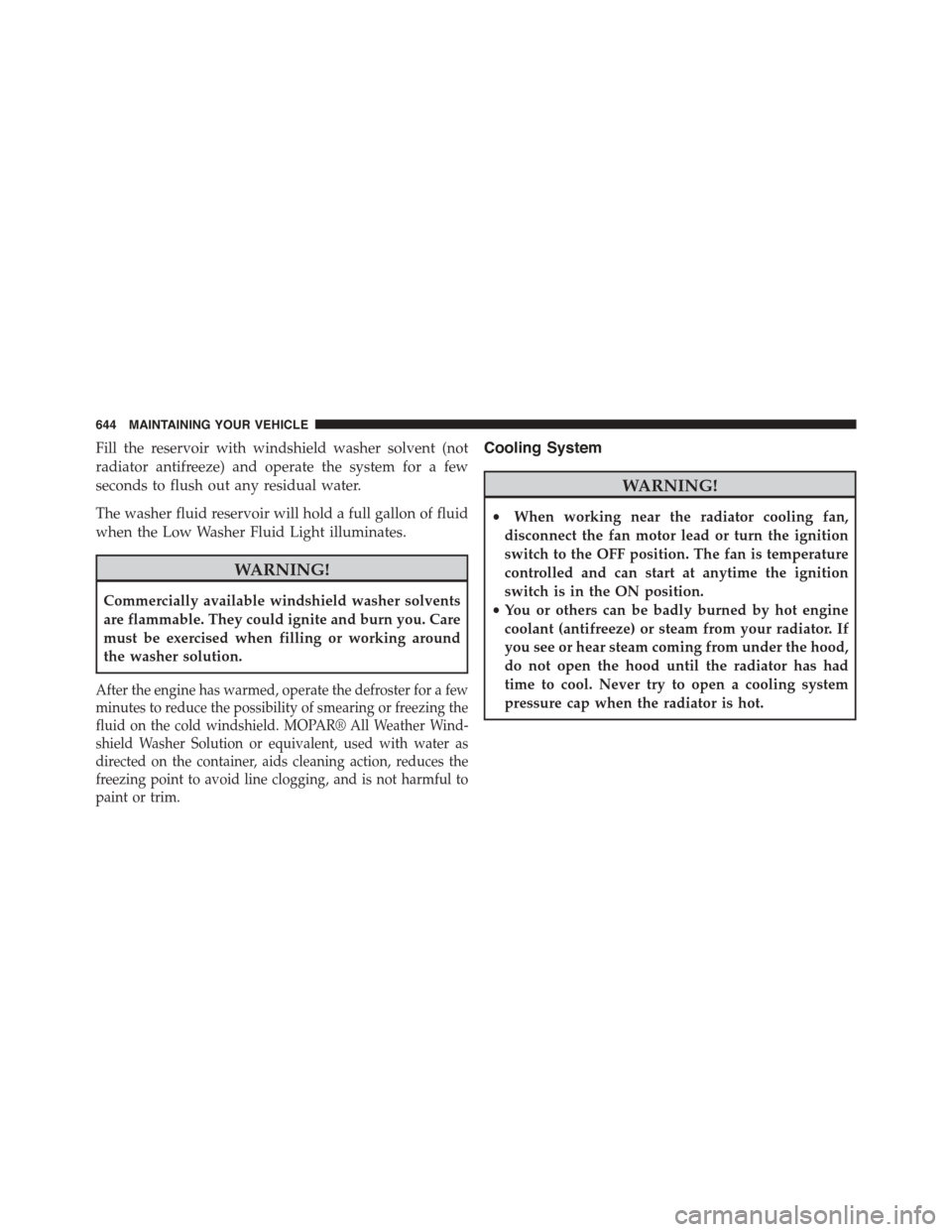
Fill the reservoir with windshield washer solvent (not
radiator antifreeze) and operate the system for a few
seconds to flush out any residual water.
The washer fluid reservoir will hold a full gallon of fluid
when the Low Washer Fluid Light illuminates.
WARNING!
Commercially available windshield washer solvents
are flammable. They could ignite and burn you. Care
must be exercised when filling or working around
the washer solution.
After the engine has warmed, operate the defroster for a few
minutes to reduce the possibility of smearing or freezing the
fluid on the cold windshield. MOPAR® All Weather Wind-
shield Washer Solution or equivalent, used with water as
directed on the container, aids cleaning action, reduces the
freezing point to avoid line clogging, and is not harmful to
paint or trim.
Cooling System
WARNING!
•When working near the radiator cooling fan,
disconnect the fan motor lead or turn the ignition
switch to the OFF position. The fan is temperature
controlled and can start at anytime the ignition
switch is in the ON position.
•You or others can be badly burned by hot engine
coolant (antifreeze) or steam from your radiator. If
you see or hear steam coming from under the hood,
do not open the hood until the radiator has had
time to cool. Never try to open a cooling system
pressure cap when the radiator is hot.
644 MAINTAINING YOUR VEHICLE
Page 647 of 726
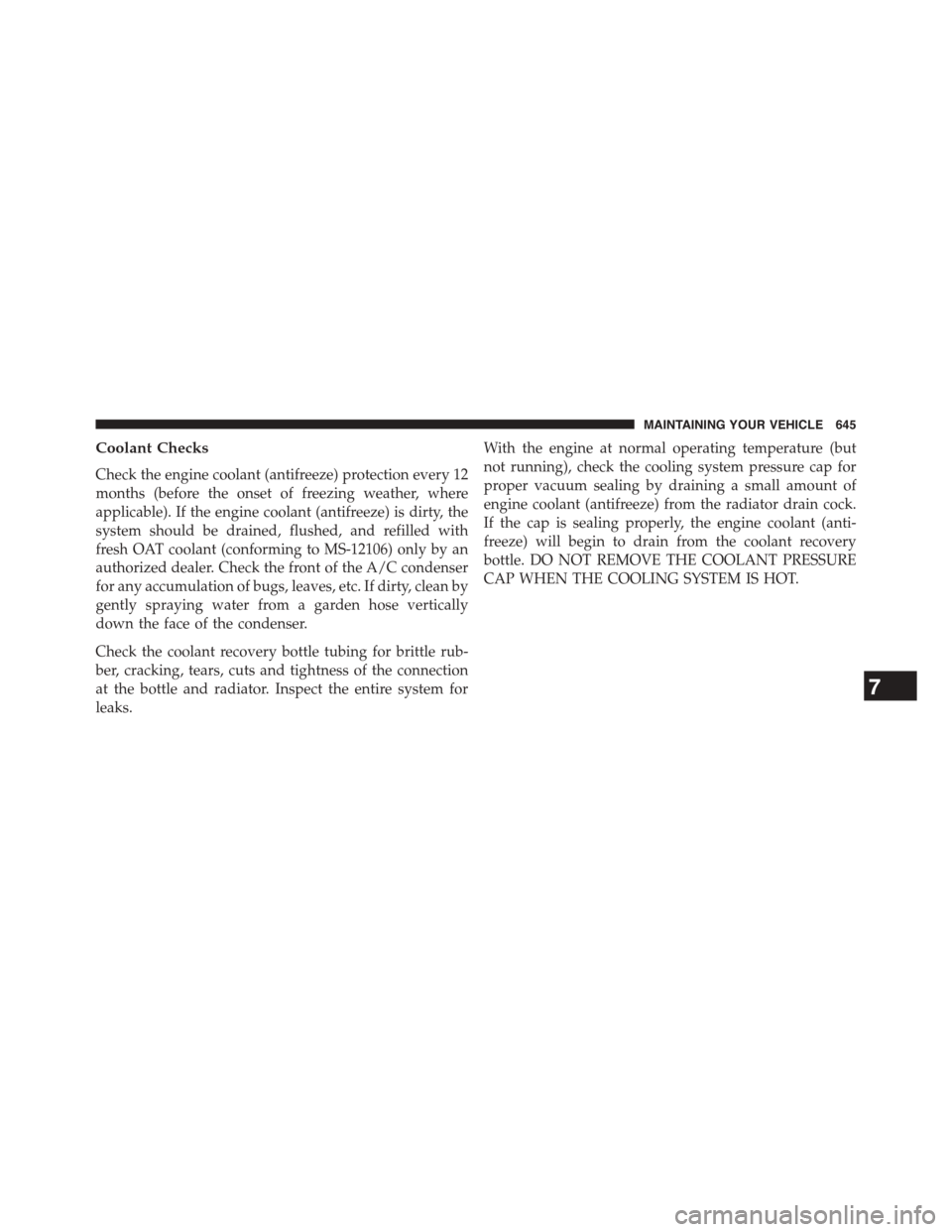
Coolant Checks
Check the engine coolant (antifreeze) protection every 12
months (before the onset of freezing weather, where
applicable). If the engine coolant (antifreeze) is dirty, the
system should be drained, flushed, and refilled with
fresh OAT coolant (conforming to MS-12106) only by an
authorized dealer. Check the front of the A/C condenser
for any accumulation of bugs, leaves, etc. If dirty, clean by
gently spraying water from a garden hose vertically
down the face of the condenser.
Check the coolant recovery bottle tubing for brittle rub-
ber, cracking, tears, cuts and tightness of the connection
at the bottle and radiator. Inspect the entire system for
leaks.
With the engine at normal operating temperature (but
not running), check the cooling system pressure cap for
proper vacuum sealing by draining a small amount of
engine coolant (antifreeze) from the radiator drain cock.
If the cap is sealing properly, the engine coolant (anti-
freeze) will begin to drain from the coolant recovery
bottle. DO NOT REMOVE THE COOLANT PRESSURE
CAP WHEN THE COOLING SYSTEM IS HOT.
7
MAINTAINING YOUR VEHICLE 645
Page 650 of 726
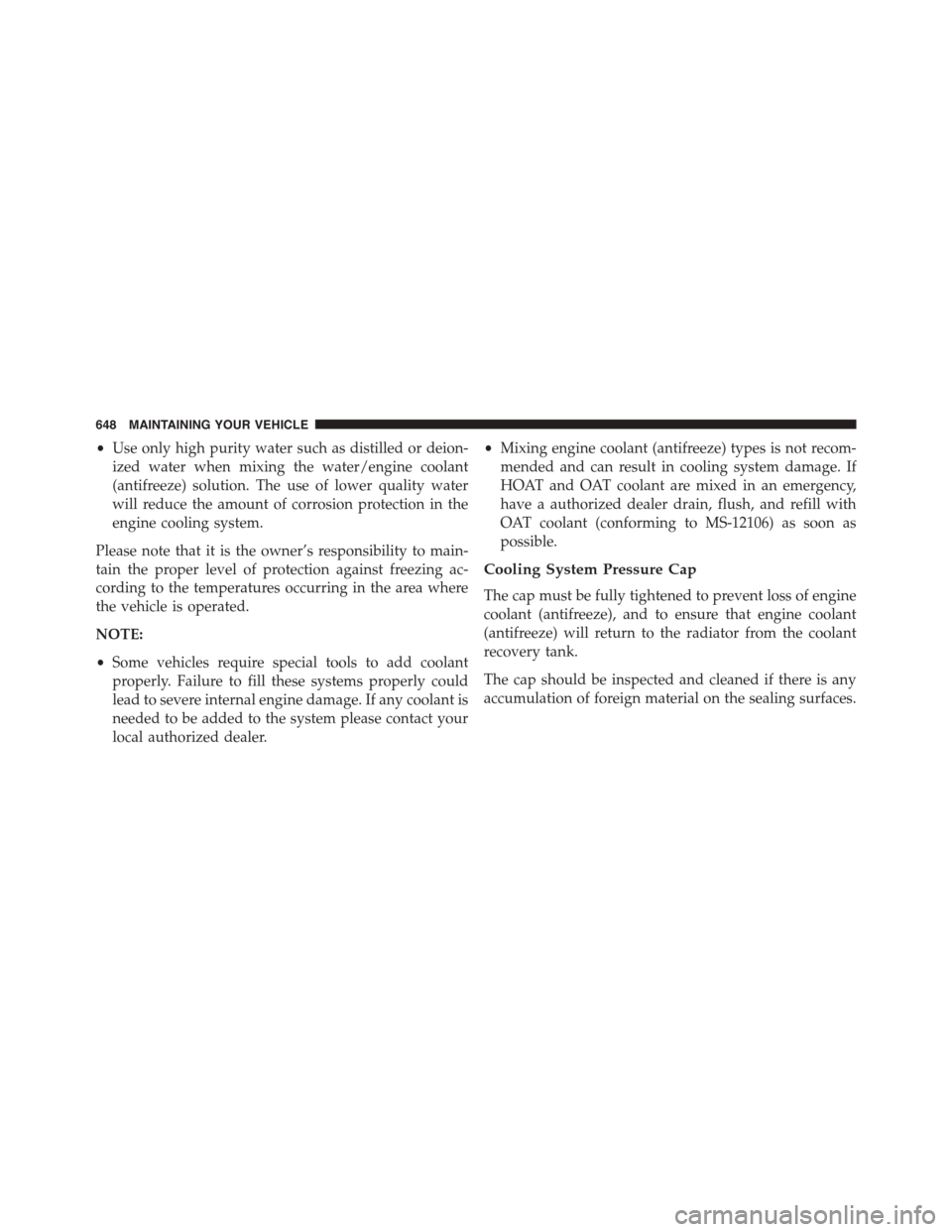
•Use only high purity water such as distilled or deion-
ized water when mixing the water/engine coolant
(antifreeze) solution. The use of lower quality water
will reduce the amount of corrosion protection in the
engine cooling system.
Please note that it is the owner’s responsibility to main-
tain the proper level of protection against freezing ac-
cording to the temperatures occurring in the area where
the vehicle is operated.
NOTE:
•Some vehicles require special tools to add coolant
properly. Failure to fill these systems properly could
lead to severe internal engine damage. If any coolant is
needed to be added to the system please contact your
local authorized dealer.
•Mixing engine coolant (antifreeze) types is not recom-
mended and can result in cooling system damage. If
HOAT and OAT coolant are mixed in an emergency,
have a authorized dealer drain, flush, and refill with
OAT coolant (conforming to MS-12106) as soon as
possible.
Cooling System Pressure Cap
The cap must be fully tightened to prevent loss of engine
coolant (antifreeze), and to ensure that engine coolant
(antifreeze) will return to the radiator from the coolant
recovery tank.
The cap should be inspected and cleaned if there is any
accumulation of foreign material on the sealing surfaces.
648 MAINTAINING YOUR VEHICLE
Page 651 of 726
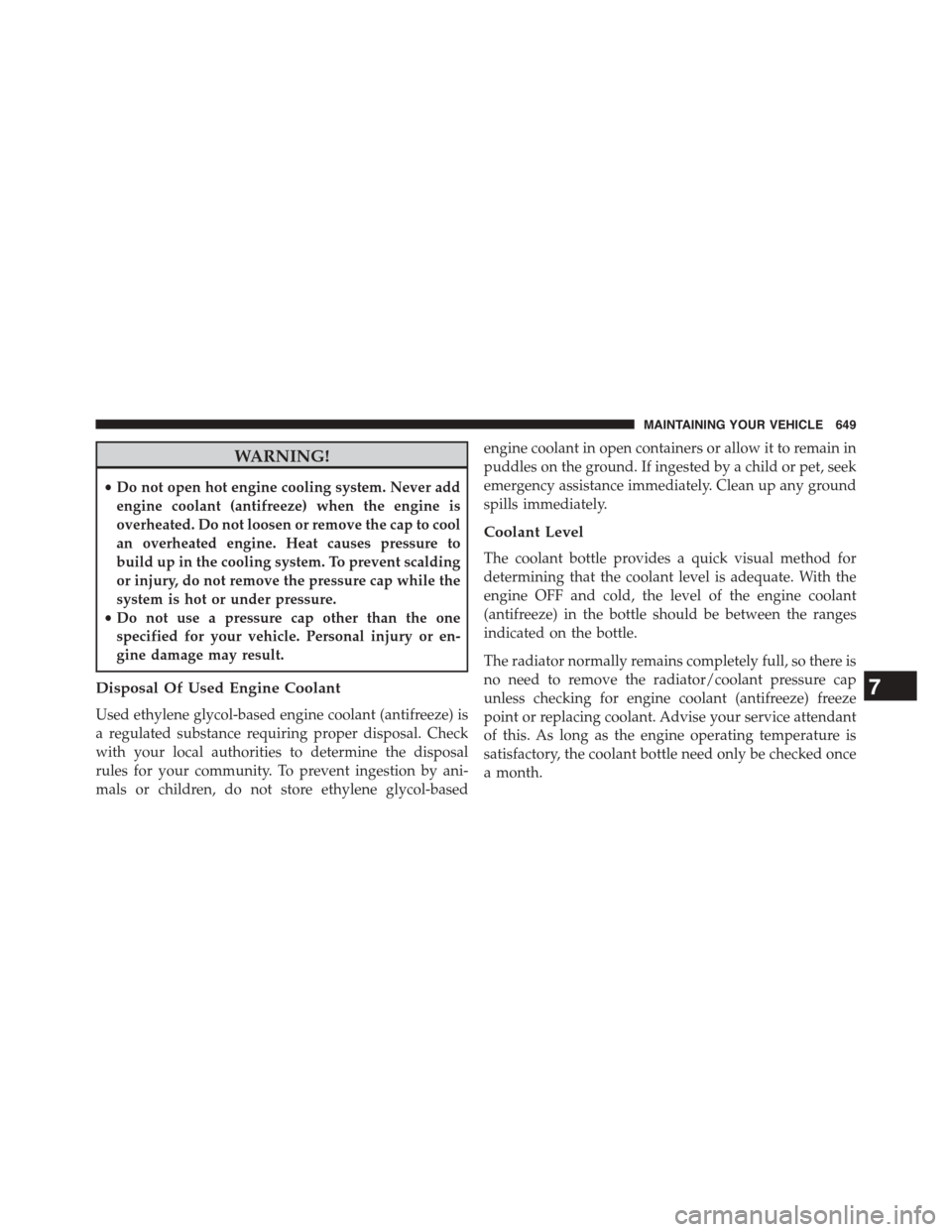
WARNING!
•Do not open hot engine cooling system. Never add
engine coolant (antifreeze) when the engine is
overheated. Do not loosen or remove the cap to cool
an overheated engine. Heat causes pressure to
build up in the cooling system. To prevent scalding
or injury, do not remove the pressure cap while the
system is hot or under pressure.
•Do not use a pressure cap other than the one
specified for your vehicle. Personal injury or en-
gine damage may result.
Disposal Of Used Engine Coolant
Used ethylene glycol-based engine coolant (antifreeze) is
a regulated substance requiring proper disposal. Check
with your local authorities to determine the disposal
rules for your community. To prevent ingestion by ani-
mals or children, do not store ethylene glycol-based
engine coolant in open containers or allow it to remain in
puddles on the ground. If ingested by a child or pet, seek
emergency assistance immediately. Clean up any ground
spills immediately.
Coolant Level
The coolant bottle provides a quick visual method for
determining that the coolant level is adequate. With the
engine OFF and cold, the level of the engine coolant
(antifreeze) in the bottle should be between the ranges
indicated on the bottle.
The radiator normally remains completely full, so there is
no need to remove the radiator/coolant pressure cap
unless checking for engine coolant (antifreeze) freeze
point or replacing coolant. Advise your service attendant
of this. As long as the engine operating temperature is
satisfactory, the coolant bottle need only be checked once
a month.
7
MAINTAINING YOUR VEHICLE 649
Page 706 of 726
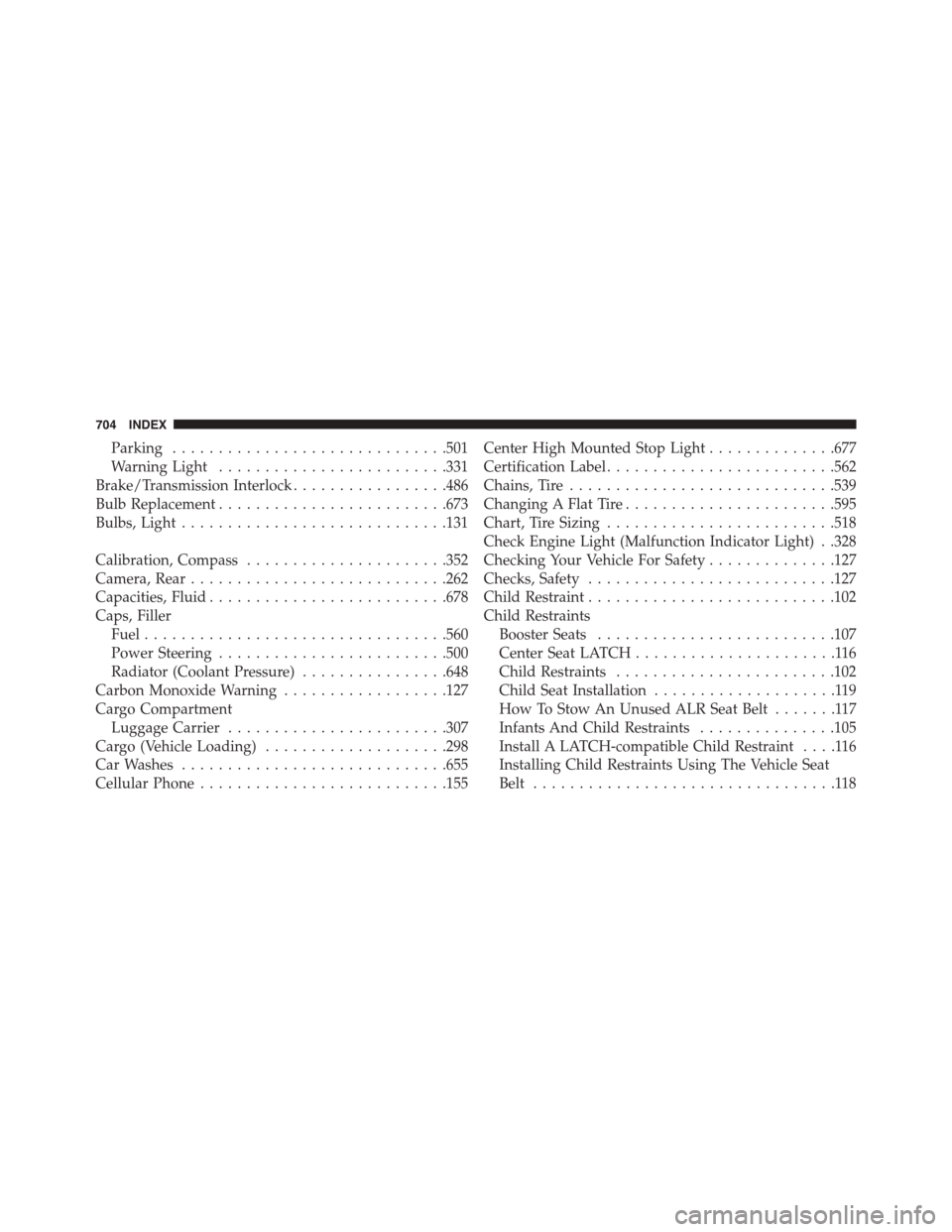
Parking..............................501
Warning Light.........................331
Brake/Transmission Interlock.................486
Bulb Replacement.........................673
Bulbs, Light.............................131
Calibration, Compass......................352
Camera, Rear............................262
Capacities, Fluid..........................678
Caps, Filler
Fuel.................................560
Power Steering.........................500
Radiator (Coolant Pressure)................648
Carbon Monoxide Warning..................127
Cargo Compartment
Luggage Carrier........................307
Cargo (Vehicle Loading)....................298
Car Washes.............................655
Cellular Phone...........................155
Center High Mounted Stop Light..............677
Certification Label.........................562
Chains, Tire.............................539
Changing A Flat Tire.......................595
Chart, Tire Sizing.........................518
Check Engine Light (Malfunction Indicator Light) . .328
Checking Your Vehicle For Safety..............127
Checks, Safety...........................127
Child Restraint...........................102
Child Restraints
Booster Seats..........................107
Center Seat LATCH......................116
Child Restraints........................102
Child Seat Installation....................119
How To Stow An Unused ALR Seat Belt.......117
Infants And Child Restraints...............105
Install A LATCH-compatible Child Restraint....116
Installing Child Restraints Using The Vehicle Seat
Belt.................................118
704 INDEX
Page 707 of 726
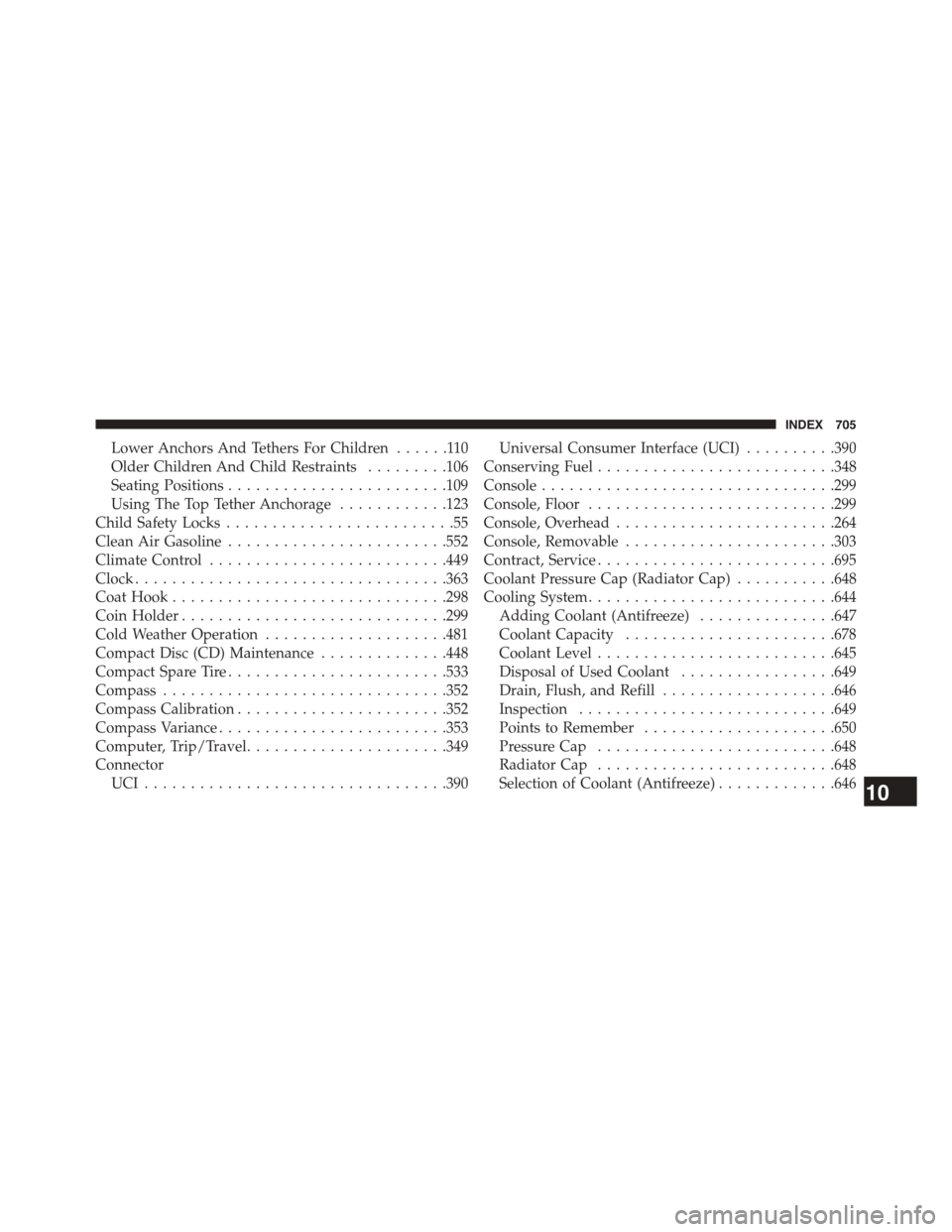
Lower Anchors And Tethers For Children......110
Older Children And Child Restraints.........106
Seating Positions........................109
Using The Top Tether Anchorage............123
Child Safety Locks.........................55
Clean Air Gasoline........................552
Climate Control..........................449
Clock..................................363
Coat Hook..............................298
Coin Holder.............................299
Cold Weather Operation....................481
Compact Disc (CD) Maintenance..............448
Compact Spare Tire........................533
Compass...............................352
Compass Calibration.......................352
Compass Variance.........................353
Computer, Trip/Travel......................349
Connector
UCI . . . . . . . . . . . . . . . . . . . . . . . . . . . . . . . ..390
Universal Consumer Interface (UCI)..........390
Conserving Fuel..........................348
Console................................299
Console, Floor...........................299
Console, Overhead........................264
Console, Removable.......................303
Contract, Service..........................695
Coolant Pressure Cap (Radiator Cap)...........648
Cooling System...........................644
Adding Coolant (Antifreeze)...............647
Coolant Capacity.......................678
Coolant Level..........................645
Disposal of Used Coolant.................649
Drain, Flush, and Refill...................646
Inspection............................649
Points to Remember.....................650
Pressure Cap..........................648
RadiatorCap..........................648
Selection of Coolant (Antifreeze).............64610
INDEX 705
Page 717 of 726
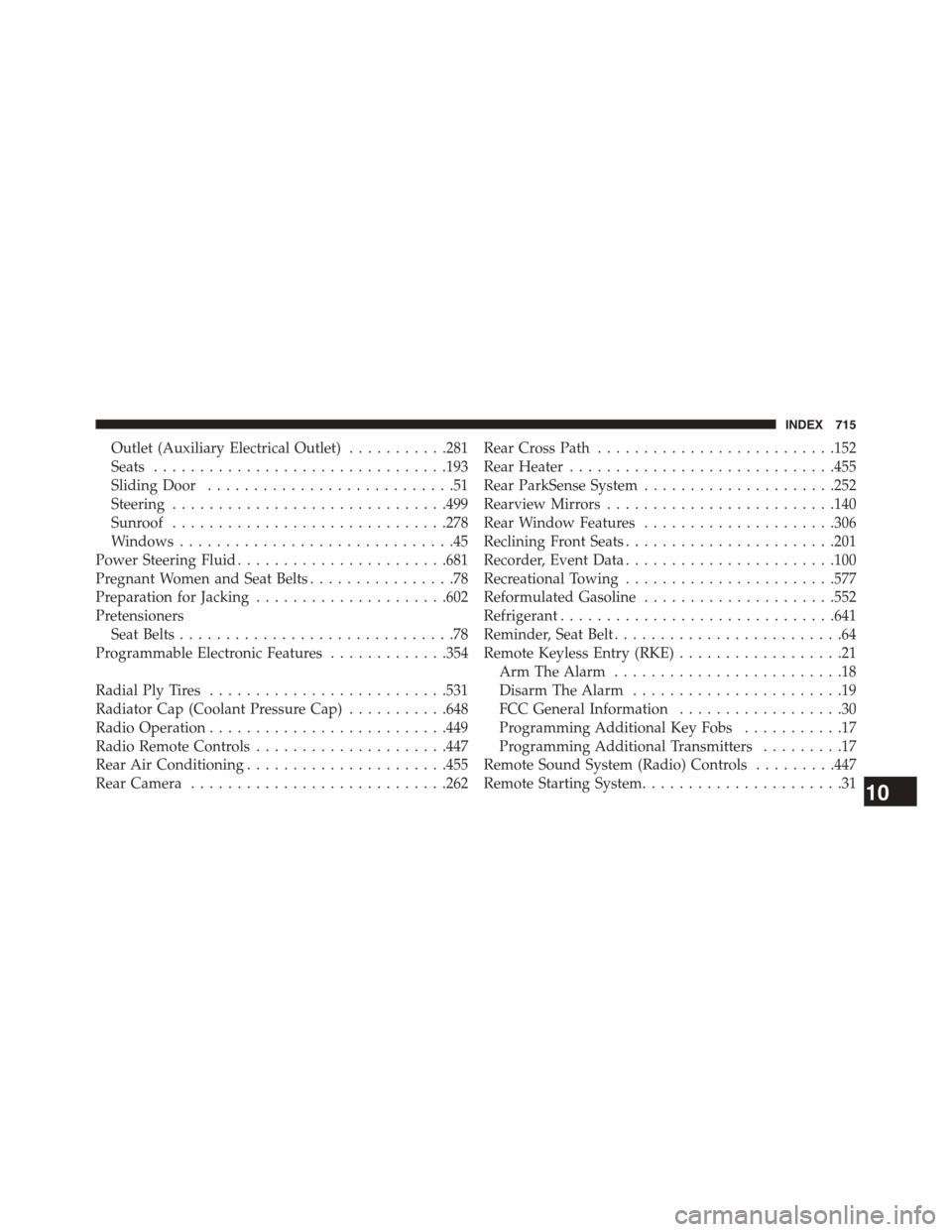
Outlet (Auxiliary Electrical Outlet)...........281
Seats................................193
Sliding Door...........................51
Steering..............................499
Sunroof..............................278
Windows..............................45
Power Steering Fluid.......................681
Pregnant Women and Seat Belts................78
Preparation for Jacking.....................602
Pretensioners
Seat Belts..............................78
Programmable Electronic Features.............354
Radial Ply Tires..........................531
Radiator Cap (Coolant Pressure Cap)...........648
Radio Operation..........................449
Radio Remote Controls.....................447
Rear Air Conditioning......................455
Rear Camera............................262
Rear Cross Path..........................152
Rear Heater.............................455
Rear ParkSense System.....................252
Rearview Mirrors.........................140
Rear Window Features.....................306
Reclining Front Seats.......................201
Recorder, Event Data.......................100
Recreational Towing.......................577
Reformulated Gasoline.....................552
Refrigerant..............................641
Reminder, Seat Belt.........................64
Remote Keyless Entry (RKE)..................21
Arm The Alarm.........................18
Disarm The Alarm.......................19
FCC General Information..................30
Programming Additional Key Fobs...........17
Programming Additional Transmitters.........17
Remote Sound System (Radio) Controls.........447
Remote Starting System......................3110
INDEX 715